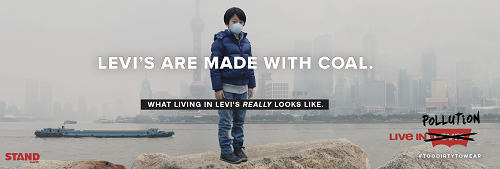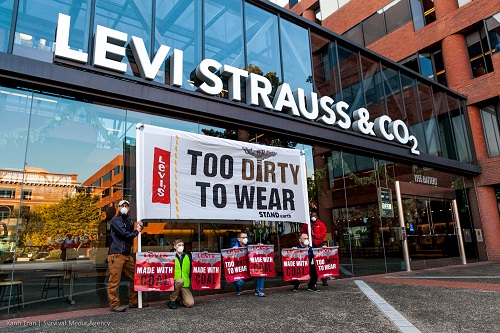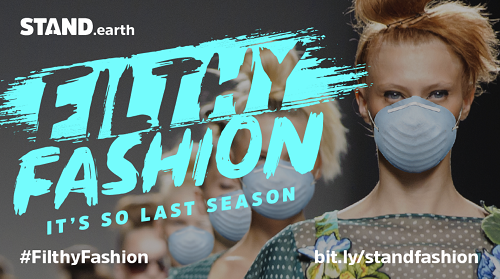
Hidden in Plain Sight – The Environmental Impacts Of Some of Our Favorite Brands
By AdministratorConsider this: 250 billion single-use coffee cups per year; they are made from forests, and they can’t be recycled.
How do you even begin to approach an issue at that scale?
Talk to Starbucks, perhaps?
Starbucks consumes more than 8,000 cups per minute, and it has known for years that its demand for single-use coffee cups is a major environmental problem. The company even made a series of public promises to create a recyclable cup. But then — time and again over ten years — the company ignored its own promises. Starbucks had made a choice: it would not work to resolve it’s single largest environmental impact.
That’s where Stand.earth stepped in.
Even though motivating Starbucks to make a different choice would not be easy (we were nervous about it, to be honest), we had to try. Not just because coffee cups were coming from forests. Not just because Starbucks cups can’t be recycled. But because persuading Starbucks to make a different decision about how its cups are made would send a powerful, global message that would show up in the hands of 15 million people per day (the number of people visiting the coffee chain daily). That type of message could actually change the entire, 250 billion single-use coffee cup sector.
 After two years of Stand.earth campaigning, that change is now happening. As Starbucks and its competitors (McDonald’s, Coca-Cola, and others) are now motivating their industry to redesign the single-use cup, we started to ask another, different question…
After two years of Stand.earth campaigning, that change is now happening. As Starbucks and its competitors (McDonald’s, Coca-Cola, and others) are now motivating their industry to redesign the single-use cup, we started to ask another, different question…
How can corporate behaviour make a bigger impact on global climate policy?
At Stand.earth, we believe government policy is the right end-point for climate action, but policy can be meaningless without political will. For the last 30 years, the environmental movement has delivered a lot of promising climate policy, but our current world requires much more than policy. We need more — and faster — action. In our experience, we have found that moving big companies can be the best way to motivate governments to take more aggressive action on meaningful policy.
So, what’s even more common than coffee cups that can mobilize more aggressive action on global greenhouse gas reductions? Could it be computers and cell phones? The store shelves of Target, Wal-mart, BestBuy? Concrete, perhaps?! You’d be surprised at the size of concrete’s climate footprint.
And then, fashion industry icon Eileen Fisher said the following:
“The clothing industry is the second-largest polluter in the world, second only to the oil industry.”
Hmm. Eileen Fisher’s statement received swift public scrutiny, and she has since backed away from it. But, quibbling over the clothing industry’s placement in a list of the world’s largest polluters misses the point. If the statement is incorrect and clothing is the 3rd or 4th most polluting industry, is that much better?
A major study by a fashion industry firm calculated that clothing is responsible for a whopping 8% of global climate pollution. If it were a country, the clothing industry would be the world’s 4th largest climate polluter, just behind China, the US, and the European Union. A little more research found that making a single pair of jeans requires 21 pounds of coal. Most of what you are wearing right now was likely made in a coal-powered manufacturing plant.
How can we shift corporate behaviour to influence global climate policy?
We had just found our answer and our next campaign. The fashion industry is very sensitive to public criticism. At the time we began our investigations, dozens of fashion companies had already made “climate commitments”. Examined more closely, however, we discovered these commitments completely ignored the vast array of factories, farms, and coal power used to produce their products. These corporate climate policies only applied to stores and offices, which represent less than 10% of the industry’s climate pollution (in some cases as low as 1%).
Stand.earth launched a campaign to persuade fashion companies to address the climate impact of their entire system of production.
- First, we put the industry on notice that ineffective climate commitments would begin facing more public scrutiny. We began inviting discussions with industry leaders to review their climate impacts and what more aggressive, corrective action should look like.
- Next, and over several months, we narrowed our discussions to a half-dozen companies that needed to make serious improvements and would actually be capable of adopting more meaningful climate policies.
- At the same time, we began organizing the Stand.earth community around the hidden, and often ignored, climate and environmental health impacts of clothing
- And then—like we did with Starbucks—we selected one company to set a higher standard for the industry and to deliver that message more broadly. Our target? Levi’s.
Levi’s eventually did the right thing. We have since been challenging the sector to meet or beat its policy and have moved more than a dozen additional companies to adopt sector leading climate commitments via a public scorecard.
To achieve these new, more aggressive, systems-oriented greenhouse gas reduction goals, we must now catalyze renewable energy options in the countries where these companies manufacture their products. We must also advocate for policy reform in China, India, Turkey, Vietnam, Bangladesh and other manufacturing hot spots. Because these next steps present a global coordination challenge larger than we or any company could possibly organize, the UN Fashion Charter was born.
Just last month, the UN Fashion Charter marked its one-year anniversary with the release of a public communique inviting governments to collaborate on climate action, noting that the majority of fashion-producing nations have signed the Paris Agreement.
The Stand.earth team was at the event in Madrid, and it is now clear to us that we have not only set the standard for what individual companies are doing when it comes to climate commitments, we are also shaping the industry’s overall ambition in the UN Fashion Charter.
The single-use coffee cup’s impact on forests? The clothing industry’s impact on greenhouse gas emissions? The easiest things to ignore are often in plain sight.
We can’t ignore them anymore.
***
Stand.earth is a beneficiary of our Humanist Grants program.Your support helps us find, vet, and fund innovative secular non-profits like this every quarter. Please help us continue this work in 2020 by contributing to our Grants Program today.




